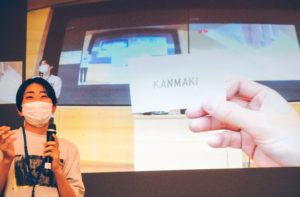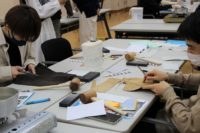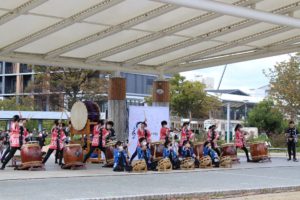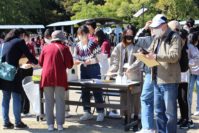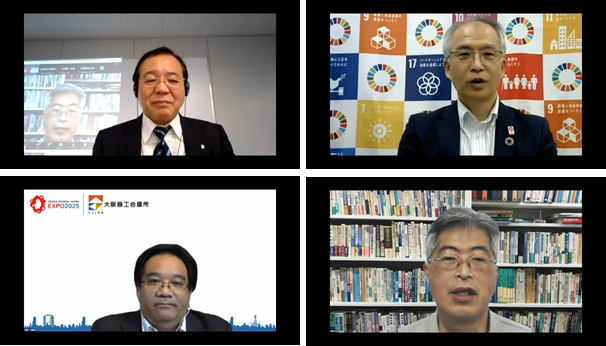We will introduce the efforts of the Reiwa 3rd year school town collaboration project.
The “Gakumachi Collaboration Project” is a “learning town collaboration project” in which universities and students and the local community collaborate to recruit and support projects and projects that work on urban development and regional revitalization in Kyoto.
We would like to inform you of the efforts of this year’s selected organizations!
【Activities】Kyoto Women’s University, Ryukoku University, etc. Chongjin Leather Industry Sustainability Project
On Sunday, December 12th, we visited the “2nd Leather Workshop”.
The “Chongjin Leather Industry Sustainability Project” is an organization consisting of members from Kyoto Women’s University, Ryukoku University, and other institutions, and is engaged in activities aimed at revitalizing citizen exchanges in the Chongin School District and making the leather industry sustainable. They met two years ago. Participating in the Miyako KAMADAKI Program, a practical program aimed at forming a network to achieve the SDGs, and launching the “Chongjin Brand” to widely know the desire to make the traditional industry “leather” sustainable, which has been protected by the Chongin district, and the “Chongin Brand” We proposed a project to collaborate with Kyoto City University of Arts to make it sustainable. Even after the program ended, the members continued to work on their own to carry out the project, and they applied for the Gakumachi Collaboration.
On this day, the second leather workshop! One in the world. Let’s make your own original bookmark & smartphone stand!” Make a bookmark and a smartphone stand using leather. There were seven participants, ranging from elementary school students to university students.
Before starting the work, the members first explained the history of the leather industry in the Chongren area using slides.
Prior to the workshop, they also visited a leather factory to learn about the leather industry, and there was also a lecture on the process from “leather” to “leather” that they had seen there. I was impressed by the impression that “when I entered the factory, I could smell the animals.”
Now that the lecture is over, it’s time to get to work! First of all, let’s choose leather.
At the venue, leather from a single animal was brought in its original size to make it easier to understand the size. It seems that the ones used on this day are pighide and cowhide. Depending on the tanning method and dye, the finished color, surface pattern, and touch comfort vary. Participants will choose from four types. Each of them has its own merits, and it is difficult to decide. After receiving advice from members and instructors about the characteristics of each leather and consulting with them about the image of what they wanted to make, it seems that they finally made a decision.
Let’s get to the smartphone! Cut the selected leather along the pattern and attach it to the plastic smartphone stand with leather bond. The outside seems to be easy to stick, but the inside is a struggle. Due to the thickness of the leather, it does not go in as much as I would like. Members who have made two prototypes will be called by the participants to provide support. It’s reliable, I’ll ♪ dry it when I’m done sticking it somehow!
I’ll start making bookmarks while I’m drying!
Cut the selected leather into the desired shape and make a hole through which the string will pass. …… And here’s where an unfamiliar tool comes in! It is called “eyelet removal”, and it is pressed against the leather and struck from above with a hammer called “mallet taiko”. Will there be people who are afraid, people who hit hard, and personalities (laughs)? It’s fun just to watch. The position was too high and it penetrated…… There was an accident that said, but that’s also the taste! !! There is only one bookmark in the world, and I get ♪ attached to it
Once the holes are drilled, the next step is to add color. This time, you can choose your favorite color from three colors: yellow, purple, and red. They use plant dyes, and in that order, yellowfin tuna, logwood, and madder. Boil each of them, and in the meantime, soak the leather in water to make it easier to color. As it began to boil, I could smell the smell of each dye, and I could hear a voice saying, “It looks delicious~” (laughs). Akane is said to smell like red beans. I see, maybe it’s because the colors are similar? The conversation is lively and seems to be fun. Put the bookmark in the boiled dye and boil it for a while to color.
Now, in the meantime, let’s take a look at how dry the smartphone stand is! The use of time is also ingenious, which is admirable. If it is dry, cut and trim the area around the leather. When you’re done cutting, you can use a soldering iron to add text and illustrations if you like. Please ♪ enjoy the finished product in the photo
In the meantime, it seems that the bookmarks have also become colored. Take it out and put it in a mordant solution in which the alum is dissolved and let the color settle. “Oh ~! Please see ♪ the photo of the finished product here
When they saw their finished work, they all seemed satisfied. It seems that there were many tasks that they were not used to, and they naturally consulted with people nearby, and university students cared about elementary school students.
【Activities】Kyoto City University of Arts, Kyoto Seika University, Seian University of Art and Design BORDER!executive committee
On Sunday, December 5th, I went to the “Art Festival BORDER!2021“.
「BORDER!The “Executive Committee” is an organization whose members are mainly art university students in the Kansai region, such as Kyoto City University of Arts, Kyoto Seika University, and Seian University of Art and Design. With the hope that it will help young artists to aspire to become artists, we plan, manage, and hold art festivals to create opportunities for young artists who will lead the next generation to present their work.
“BORDER” means “border”. There is a line between art and what is not. An invisible line that says, “I can’t do it.” The boundaries of genres. The name expresses the hope that you will be able to jump over such various boundaries and create wonderful encounters.
In 2018 and 2019, Miyako Messe held a live painting, food, and art market. In 2020, we held an online web exhibition and live painting in front of the Kyoto City Kyocera Museum of Art.
This year, there were concerns about the impact of the new coronavirus, but we decided to hold the event in person based on the demand for face-to-face events such as “people who come to see other exhibitors can see them” and “you can enjoy meeting people who are next to you at the exhibition location,” as well as the loss of opportunities for artists to present their art and people’s art due to the closure of museums. As usual, I hoped that it would catch the eye of people who came to shop, and I held it at Zest Oike with high hopes for a chance encounter.
The theme is “Rinko Nekushon”. It is said that the word “link”, “connect”, and “linker nation” are tightly attached together. Connect and connect. And I imagine that the circle will expand in an infinite chain.
Now, let’s take a look at the venue. In each of the three squares, live painting, a market, workshops and art supply booths were held.
First of all, it is a live painting venue. It seems that four students will complete their work within 5 hours of the event, and at the same time as the MC announces, they will go to a large canvas about 1m wide × 2m high and start drawing! People who passed by the venue also stopped and watched the powerful scene.
I’d like to see it all the time, but the next stop is the Marche venue! A Mr./Ms. of 33 artists exhibits and sells handmade accessories, wallets, bags, vessels, paintings, illustrations, etc. There were people who bought it because they thought it was cute ♪, and there were people who were talking to the artist Mr./Ms. with great interest, saying, “How do you draw this?” You can also hear about the thoughts put into the work and the process of creating the work, so I think that many of those who purchased it were able to experience a special feeling.
Lastly, there is the workshop and art supply store booth venue. Here, workshops planned by the students themselves are held to “let people actually experience art!”, and art supply store Mr./Ms. who handles art materials that are indispensable for the production of works are exhibited and you can experience them.
In the workshop, students create works using a technique called “marbling,” in which patterns on the surface of the water are copied onto pieces of wood or paper, which are made by dripping colored ink or paint on water. When I talked to the students who planned it, they said that marbling is a technique that uses patterns and colors that can be created by chance (it is called a modern technique!). He decided to use this technique because he wanted people who are not usually involved in art to enjoy it casually, and as the event itself, he wanted people to enjoy chance encounters. Two pieces of wood are selected and one is used for oneself and the other is for the exhibition, so that the viewer can enjoy it. It was said that adults take more time to make it than children. It’s a great success as a ♪ project
Now that we’ve come full circle, let’s go back to the live painting venue! The work is steadily approaching completion! It’s not finished yet, but please enjoy the photos.
We also talked to Mr./Ms. Gashindo, who came up with the idea of this initiative. “If we continue to do business on our own for a long time, we tend to do the same thing, so we asked the students Mr./Ms. to bring in a new wind. When I actually do it, I feel the youthful power of the student Mr./Ms., and I am often inspired by their ideas. I hope that we will continue to do so for a long time and that the base will gradually expand.”
“BORDER!2021” was only held on December 5th, but the website is also very attractive, so please take a look at it Mr./Ms. ♪ there are many interview articles with the artists Mr./Ms. exhibited this time. In addition, in the past, there have been rare side-scrolling specifications. Even if you couldn’t make it to the event this time, please try the art!
Click here for the website of BORDER!2021! ⇒ https://borderfes.art/
【Activities】Bukkyo University Waku Waku Laboratory
On Wednesday, December 1st, I observed the filming of a video for the online science class of the “Children’s Science Class”.
The “Waku Waku Laboratory” is an organization consisting of students of the Hirata Seminar (Science Education) of the Faculty of Education, Bukkyo University. This year’s team has 13 members. Since 2016, students have been planning and operating the “Children’s Science Class” with the aim of promoting the spread of science for children as part of the seminar’s social contribution activities. Until 2019, we held science experiment classes mainly for elementary school students at Zest Oike and student festivals (@平安神宮), mainly in the Kitano shopping district. In 2020, we were unable to hold the event due to the coronavirus pandemic, but this year, we are newly based at the Rakuda Children’s Center, which is closer to the university.
In July, we were able to hold a children’s science class at the children’s center, but in August, due to the declaration of a state of emergency, the two scheduled classes were canceled. The effects of the Corona disaster are still unsettled, so let’s try an online science class! So, on this day, I shot a video for that.
When I arrived at the shooting venue, I was greeted by 11 students in white coats.
The theme of this year’s event is “Science experiments that can be done at home!!” It seems that two experimental videos will be filmed. After considering what to use for shooting, I decided that it was easy to edit later on a smartphone! So, I started shooting with my smartphone.
First of all, make crack marbles! Put the marbles in a pot on a gas stove and heat them over medium ~ high heat for about 10 minutes while rolling the marbles. When you’re done heating, take out the marbles and put them in ice water! If you put it in vigorously, the marble itself will break, so the point is to put it in gently. This is also chilled for about 10 minutes. The marbles were beautifully cracked.
It seems that he tried using a toaster oven instead of a gas stove, but it is difficult to get heat evenly or the amount of heat is not enough, so the gas stove can be done better.
Next, make unbreakable soap bubbles! It was a dream to touch soap bubbles, wasn’t it~ ♪ Maybe it will come true today! It is a challenge with two patterns of soap bubble liquid.
First of all, kitchen detergent, laundry glue, and sugar.
Measure each ingredient in a beaker, mix well, and let it sit for a while.
Finally, let’s fly the soap bubbles! …… And work gloves in the hands of those who are waiting for soap bubbles! !!
The fibers stand out on the surface of the work gloves, and they act like cushions, making it difficult for soap bubbles to break. I see, it’s one of the important goods.
With the cry of “I’m going!”, the soap bubble is blown away and received. “Whoa!!” he jumps up on his ♪ work gloves and succeeds!
Now, the next step is to add a lotion containing hyaluronic acid to a commercially available soap bubble solution.
This one seems to be struggling quite a bit. It cracks quickly, so add a lotion with hyaluronic acid to fine-tune it. The recipient also cooperates with the effort by turning the palm of the hand wearing work gloves up and down, but I feel that the purpose of this experiment is different…… (laughs)
I struggled a little with the results of the experiment, but the shooting was successfully completed! After this, the video will be edited and the explanation (audio) of the experiment will be included.
By the way, this time, the theme was “You can do it at home!”, but taking advantage of the advantages of online, “You can do it because it is a science room!!” They are planning to film dynamic experiments that cannot be done in a normal children’s science class, and to make experimental videos that people can enjoy just by looking at them. I’m ♪ looking forward to that as well
【Activities】Otani University And House
On Thursday, November 4th, we observed the labeling of beer bottles for the “Rediscovering Life in the Nakagawa School District – Beer with Tea Project”.
“And House” is an organization centered on students of the Shito Seminar of the Department of Community Design, Faculty of Sociology, Otani University. Since 2015, we have been working in the Nakagawa area of Kita-ku, Kyoto City, where depopulation and aging are progressing, to learn about community development, including thinking about the inconvenience of transportation and the issues of daily welfare.
I would like many people to know and be interested in the many beautiful natures, cultures, and fascinating historical lives of the people that I noticed in the process! One of the attempts to start is the “Rediscovering the Life of the Nakagawa School District – Beer with Tea Project”.
Through the production of “Manma Bea!”, a craft beer using “Manma tea” that has been grown in the region for generations as it was when tea was introduced to Japan and has been drunk in between mountain work, we are working to further deepen our connection with the local community and expand our connections with people who are attracted to Nakagawa.
On this day, all the seminar students worked together to apply labels, which is one of the manufacturing processes of “Manma Bea!”.
First of all, you will receive a brief explanation from the teacher. If you make a mistake, you will be asked to buy it with the contents inside!!” One student said, “I’d be happy to buy it (laughs).” Yes, there was no beer in it that day. I was expecting a little bit to be able to taste it, but I was disappointed (laughs).
On October 2nd and 3rd, several students (the number of participants is limited due to the Corona disaster) went to pick tea and made tea leaves, which were brewed with Nishijin barley wine operated by the affiliated organization NPO HEROES, and it seems that it will be completed soon. It is scheduled to go on sale in early December. I’m looking forward to it, and ♪ it seems that you can also buy it from the Nishijin Beer online store!
600 beer bottles and labels are brought into the classroom, and the leader of the third-year students gives instructions such as dividing the students into groups. This is the third year, so the third-year students are also labeling for the third time. Upper-year students also have the role of teaching first-year students!
The bottle has a vertical line, and the label is easy to apply if you match the line. The position of the label should not be too high or too low. Of course, it is useless if air enters on the way. It seems that it takes a lot of concentration, and everyone’s faces are serious. When you finish pasting, show it to each other in the group and check it.
When I talked to a second-year student who was working while teaching first-year students, he seemed to be satisfied, saying, “(First-year students) absorb it ♪ like a sponge.” When the first-year students heard this, they were embarrassed but happy to laugh. This is how it is passed down from generation to generation.
Among the third-year students, the veteran group went around to inspect the products and checked the quality as quickly as a craftsman. I will give instructions for OK and repasting. I can count on you.
We also spoke to the next leader. While the number of participants in the event was limited due to the Corona disaster, he said that if he still had fun and actively participated, he would naturally become a leader. He said, “It’s fun to get involved with people in the community and hear things I don’t know!” While working on making tea leaves, he talked nostalgically about the history of tea and his childhood (in the past, the whole community used to work together).
He is also from an area where the forestry industry is thriving, and there are similarities. Maybe it’s a sense of hometown and calming down.
As a group, they also hold concerts at local facilities for the elderly, but they are currently unable to hold them due to the influence of the Corona disaster.
As I listened to their stories, I was reminded that it is really important to continue to do what we can and not to lose our connection. There are 3~40 students in the seminar. Each person may have their own thoughts, but it was a label that made me feel the importance of working on one thing and being involved in one thing.
【Activities】Kyoto Tachibana University Daigomi ETS Meeting
On Saturday, October 23rd, I visited the “Daiwa ETS” held at Umekoji Park.
“Daigomi EETS ” is a project that aims to deepen cooperation and relationships among various entities such as citizens, businesses, students, and children in the Daigo region, where the birthrate is declining and the population is aging, and to make people feel the charm of the region anew by touring the Daigo region through events.
Since 2019, we have been holding stage events at multiple venues in the Daigo area of Fushimi Ward, where students and students from nearby elementary, junior high, and high schools and university clubs and circles showcase the results of their daily activities, such as brass bands, light music, Japanese drums, a cappella, dance, and batons.
In FY2019, the event was held at Paseo Daigoro, Tatsumi Bathhouse, and MOMO Terrace, and in FY2020, it was held at the Kyoto City Daigo Exchange Hall Hall, but this year, due to the ongoing coronavirus pandemic, we are considering holding it outdoors. We tried to hold the event in the Daigo area, but we had no choice but to abandon it due to the scale, setup, and budget of the event, and even after it was finally decided to hold it in Umekoji Park, we were forced to postpone it due to the declaration of a state of emergency.
Then came the day. Although some groups were unable to participate at the last minute due to the good weather, we were able to finish the entire program safely.
Last year, the opening parade, which was canceled due to the coronavirus pandemic, was also held, and the audience was fascinated by the energetic smiles of the high school students and the sharp marching band.
On the presentation stage, GReeeeN’s “Kiseki”, “Sing Sing Sing”, “Lupin III’s Theme”, and other songs that can be enjoyed by a wide range of generations were played, and some groups introduced the songs while performing famous scenes from the movie “Titanic”! The venue was very excited.
It seems that many groups were not able to practice as much as they wanted due to the coronavirus pandemic or had fewer opportunities to present, but in the interviews after the performance, we heard voices of joy at the event, such as “We practiced efficiently by cooperating and concentrating in a limited time,” “I am happy to be able to perform in front of many people for the first time in a long time,” and “I feel a sense of freedom.”
The fact that the entire event was managed, reception, and stage proceedings were mainly conducted by students was also reassuring and smiling.
At the finale, it seems that a joint performance was also held by volunteers from all participating organizations, and I think that both participants and Mr./Ms. audience felt a sense of unity!
This year, the event was held outside the Daigo area, but those who visited were lucky enough to know about Daigo ETS at this event! In the future, when it is held in the Daigo area, please visit ♪ it
 The report collection of the 19th Forum on Collaborative High School-University Education “From Exploratory Learning to Research: Becoming a Jumping Board for Educational Reform” held on Saturday, December 4, 2021 has been completed.
The report collection of the 19th Forum on Collaborative High School-University Education “From Exploratory Learning to Research: Becoming a Jumping Board for Educational Reform” held on Saturday, December 4, 2021 has been completed.

















